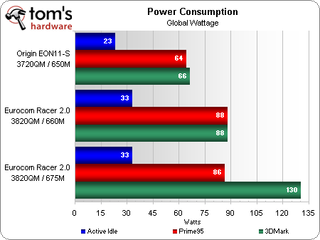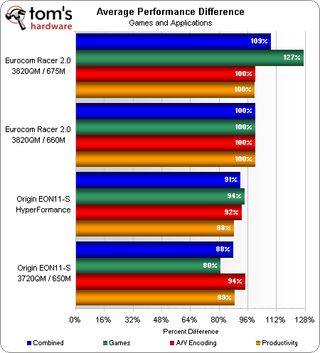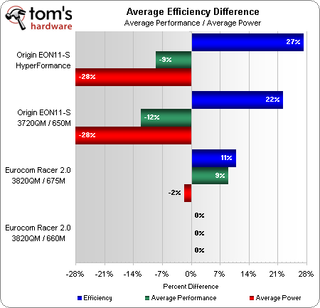Origin PC Eon11-S: Great Gaming Performance From A Tiny Notebook?
Is the tug-of-war between gaming performance and portability finally over? Origin PC believes that Lucidlogix's software can help bring these two ideas together, combining Nvidia's GeForce GT 650M and Intel's Core i7-3720QM in an 11.6” chassis.
Energy, Battery Life, And Efficiency
Moderate power consumption is mandatory for mobility, since large batteries and oversized heat sinks contribute to both size and weight. The Eon11-S has an exceptionally low power profile, and the scaling of these graphs makes it pretty clear that a number of components play important roles in keeping energy use low on the Origin PC configuration.

The Eon11-S’s compact chassis demands a smaller and lower-capacity battery compared to the Racer 2.0. But because its power consumption is so low, it's able to deliver longer battery life.

Battery Eater Pro represents a distinctly synthetic test, so we also wanted to see how long each of these gaming-oriented notebooks could sustain real-world 3D workloads before running out of juice. The Eon11-S also tops our records there, running Battlefield 3 for 50 minutes, beating the GeForce GTX 660M-equipped Racer 2.0 by seven minutes, and doubling the game time afforded to the Racer 2.0’s battery by Nvidia's GeForce GTX 675M.

Efficiency compares work to energy, and we use a simple chart of performance averages to gauge how much work each of these systems achieves. The mid-power, mid-sized Racer 2.0 with GeForce GTX 660M graphics sets the baseline.

A 28% power savings sounds like a great tradeoff for a 9% performance loss, so long as that 9% doesn't keep the system from being fast enough to satisfy its target audience. The Eon11-S is a gaming notebook, after all, and we’ll discuss how it fits in that role on the next page.
Stay on the Cutting Edge
Join the experts who read Tom's Hardware for the inside track on enthusiast PC tech news — and have for over 25 years. We'll send breaking news and in-depth reviews of CPUs, GPUs, AI, maker hardware and more straight to your inbox.
Current page: Energy, Battery Life, And Efficiency
Prev Page Benchmark Results: Productivity Next Page Know What You're Getting Into...And EnjoyMost Popular


